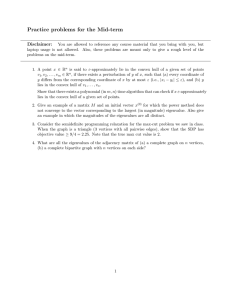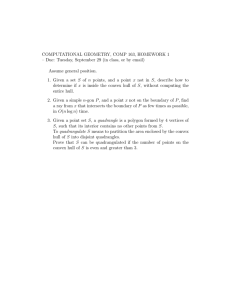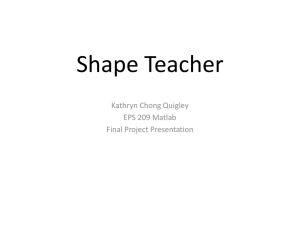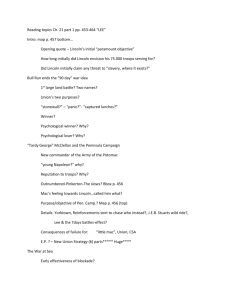Fast Projected Area Computation for Three-Dimensional
advertisement
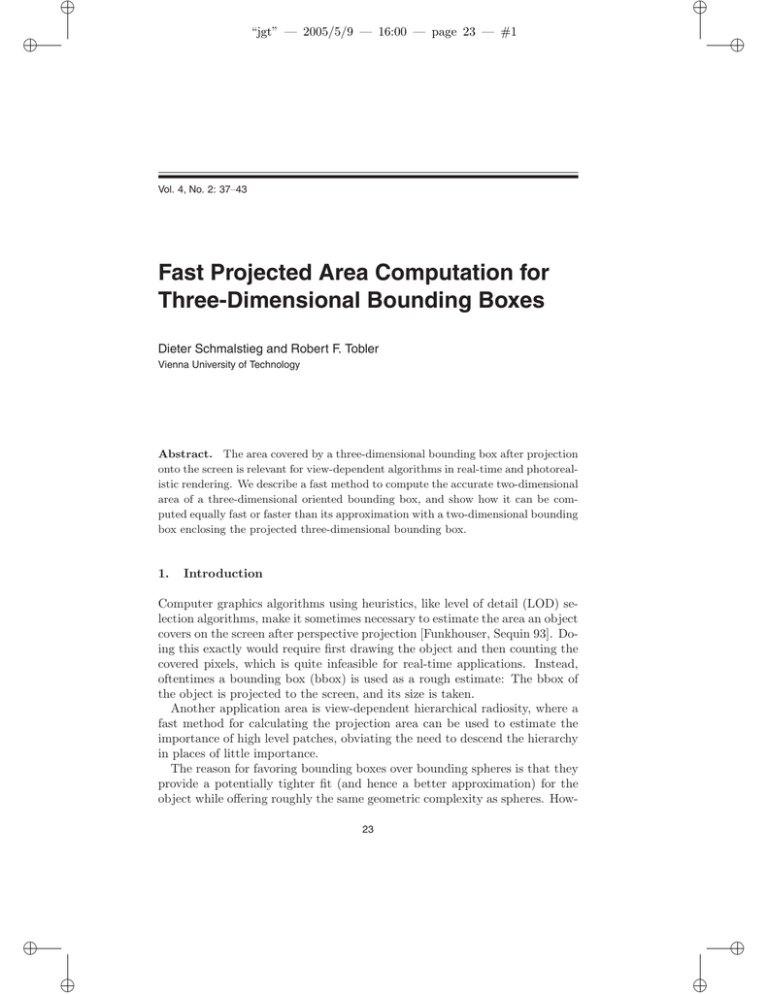
i
i
“jgt” — 2005/5/9 — 16:00 — page 23 — #1
i
i
Vol. 4, No. 2: 37–43
Fast Projected Area Computation for
Three-Dimensional Bounding Boxes
Dieter Schmalstieg and Robert F. Tobler
Vienna University of Technology
Abstract. The area covered by a three-dimensional bounding box after projection
onto the screen is relevant for view-dependent algorithms in real-time and photorealistic rendering. We describe a fast method to compute the accurate two-dimensional
area of a three-dimensional oriented bounding box, and show how it can be computed equally fast or faster than its approximation with a two-dimensional bounding
box enclosing the projected three-dimensional bounding box.
1.
Introduction
Computer graphics algorithms using heuristics, like level of detail (LOD) selection algorithms, make it sometimes necessary to estimate the area an object
covers on the screen after perspective projection [Funkhouser, Sequin 93]. Doing this exactly would require first drawing the object and then counting the
covered pixels, which is quite infeasible for real-time applications. Instead,
oftentimes a bounding box (bbox) is used as a rough estimate: The bbox of
the object is projected to the screen, and its size is taken.
Another application area is view-dependent hierarchical radiosity, where a
fast method for calculating the projection area can be used to estimate the
importance of high level patches, obviating the need to descend the hierarchy
in places of little importance.
The reason for favoring bounding boxes over bounding spheres is that they
provide a potentially tighter fit (and hence a better approximation) for the
object while offering roughly the same geometric complexity as spheres. How23
i
i
i
i
i
i
“jgt” — 2005/5/9 — 16:00 — page 24 — #2
i
Vol. 4, No. 2: 37–43
i
journal of graphics tools
Figure 1. Axis-aligned bounding boxes (left) are often inferior to oriented bounding
boxes (right).
ever, usually axis-aligned bboxes are used, which can also be a poor fit for
the enclosed object. In contrast, an oriented bounding box (OBB) requires
an additional transformation to be applied, but allows a comparatively tight
fit (Figure 1). The speed and applicability of OBBs in other areas has been
shown by Gottschalk et al. [Gottschalk et al. 96]. For the construction of
an OBB, refer to [Wu 92]. To estimate the two-dimensional area of a threedimensional object when projected to the screen, one can find the perspective
projection of the corners of an axis-aligned bbox, and then use the area of
the rectangle (two-dimensional bbox) enclosing the three-dimensional bbox
to estimate the area of the object on the screen. This procedure entails two
nested approximations which are not necessarily a tight fit, and the error can
be large.
Instead, we directly project an OBB and compute the area of the enclosing
two dimensional polygon. This procedure yields significantly better approximations. Moreover, we will show that the procedure can be coded to require
fewer operations than the nested bbox approach.
2.
Algorithm Overview
In this section, we will show how a simple viewpoint classification leads to an
approach driven by a lookup table, followed by an area computation based
on a contour integral. Both steps can be coded with few operations and are
computationally inexpensive. When a three-dimensional box is projected to
the screen either one, two, or three adjacent faces are visible, depending on
the viewpoint (Figure 2):
• Case 1: one face visible, two-dimensional hull polygon consists of four
vertices
• Case 2: two faces visible, two-dimensional hull polygon consists of six
vertices
24
i
i
i
i
i
i
“jgt” — 2005/5/9 — 16:00 — page 25 — #3
i
i
Schmalstieg and Tobler: Fast Projected Area Computation for 3D Bounding Boxes
Figure 2. One, two, or three faces of a box may be visible.
• Case 3: three faces visible, two-dimensional hull polygon consists of
six vertices
Whether a particular placement of the viewpoint relative to the bbox yields
Case 1, 2, or 3, can be determined by examining the position of the viewpoint
with respect to the six planes defined by the six faces of the bbox. These six
planes subdivide Euclidean space into 33 = 27 regions. The case where the
viewpoint is inside the box does not allow meaningful area computation, so
26 valid cases remain.
By classifying the viewpoint as left or right of each of the six planes, we
obtain 26 = 64 theoretical cases, of which 26 are valid. For each of these cases
we describe the hull polygon as an ordered set of vertex indices which can
be precomputed and stored in a two-dimensional lookup table, called the hull
vertex table.
An efficient implementation of the classification is to transform the viewpoint in the local coordinate system of the OBB, where each of the planes
is parallel to one of the major planes, and the classification can be made by
comparing one scalar value.
After the classification, the area of the hull polygon must be computed from
the bbox vertices given in the hull vertex table. Our sample implementation
uses a fast contour integral [Foley et al. 90].
3.
Implementation
For an efficient implementation, the central data structure is the hull vertex
table. It stores the ordered vertices that form the outline of the hull polygon
after projection to two dimensions, as well as the number of vertices in the
outline (four or six, with zero indicating an invalid case). The table is indexed
with a 6-bit code according to Table 1.
25
i
i
i
i
i
i
“jgt” — 2005/5/9 — 16:00 — page 26 — #4
i
Vol. 4, No. 2: 37–43
Bit
Code
i
journal of graphics tools
5
back
4
front
3
top
2
bottom
1
right
0
left
Table 1. Bit code used to index into the hull vertex table.
By precomputing this table, many computational steps can be saved when
a bounding box area is computed at runtime. The hull vertex table used in
the sample implementation is shown in Table 2.
Using this hull vertex table (hullvertex), the following C function
calculateBoxArea computes the projected area of an OBB from the viewpoint given in parameter eye and the bounding box bbox given as an array of
eight vertices (both given in local bbox coordinates). We assume an auxiliary
function projectToScreen, which performs perspective projection of an OBB
vertex to screen space.
float calculateBoxArea(Vector3D eye, Vector3D bbox[8])
{
Vector2D dst[8]; float sum; int pos, num, i;
int pos = ((eye.x < bbox[0].x)
)
// 1 = left
| compute 6-bit
+ ((eye.x > bbox[7].x) << 1)
// 2 = right
|
code to
+ ((eye.y < bbox[0].y) << 2)
// 4 = bottom |
classify eye
+ ((eye.y > bbox[7].y) << 3)
// 8 = top
|with respect to
+ ((eye.z < bbox[0].z) << 4)
// 16 = front
| the 6 defining
+ ((eye.z > bbox[7].z) << 5);
// 32 = back
|
planes
if (!num = hullvertex[pos][6]) return -1.0;
//look up number of vertices
//return -1 if inside
for(i=0; i<num; i++) dst[i]:= projectToScreen(bbox[hullvertex[pos][i]]);
sum = (dst[num-1].x - dst[0].x) * (dst[num-1].y + dst[0].y);
for (i=0; i<num-1; i++)
sum += (dst[i].x - dst[i+l].x) * (dst[i].y + dst[i+1].y);
return sum * 0.5;
//return corrected value
}
4.
Discussion
The proposed implementation gives superior results to a simple “twodimensional bbox of three-dimensional bbox” implementation. However, although it yields better accuracy, it can be implemented to use slightly fewer
operations than the simple two-dimensional bbox variant. Our algorithm is
composed of the following steps:
1. Transformation of the viewpoint into local bbox coordinates: Note
that this step is not included in the sample implementation. Given
the transformation matrix from world coordinates to local bbox coordinates, this is a simple affine transformation a three-dimensional
26
i
i
i
i
i
i
“jgt” — 2005/5/9 — 16:00 — page 27 — #5
i
i
Schmalstieg and Tobler: Fast Projected Area Computation for 3D Bounding Boxes
Case
0
1
2
3
4
5
6
7
8
9
10
11
12
13
14
15
16
17
18
19
20
21
22
23
24
25
26
27
28
29
30
31
32
33
34
35
36
37
38
39
40
41
42
≥ 43
Num
0
4
4
0
4
6
6
0
4
6
6
0
0
0
0
0
4
6
6
0
6
6
6
0
6
6
6
0
0
0
0
0
4
6
6
0
6
6
6
0
6
6
6
0
Vertex Indices
0
1
4
2
7
6
3
5
0
0
0
1
1
1
5
2
2
4
6
6
5
5
4
4
2
4
2
3
7
3
7
6
7
6
2
6
3
5
0
1
0
0
0
3
4
3
2
7
2
1
3
6
2
5
1
1
0
1
0
3
5
3
2
4
2
1
7
6
5
3
5
4
2
4
0
0
0
3
4
3
7
7
7
6
6
6
2
2
5
1
1
1
4
4
1
5
5
2
6
6
6
7
7
7
3
4
0
5
0
0
0
1
1
1
5
5
2
6
6
6
7
7
7
4
3
4
2
0
1
3
4
2
7
5
3
4
6
7
5
2
4
6
3
5
Description
inside
left
right
bottom
bottom, right
bottom, right
top
top, left
top, right
front
front, left
front, right
front, bottom
front, bottom, left
front, bottom, right
front, top
front, top, left
front, top, right
back
back, left
back, right
back, bottom
back, bottom, left
back, bottom, right
back, top
back, top, left
back, top, right
-
Table 2. The hull vertex table stores precomputed information about the projected
bbox.
27
i
i
i
i
i
i
“jgt” — 2005/5/9 — 16:00 — page 28 — #6
i
Vol. 4, No. 2: 37–43
i
journal of graphics tools
vector is multiplied with a 3 × 4 matrix, using 12 multiplications and
nine additions.
2. Computation of the index into the hull vertex table: To perform this
step, the viewpoint’s coordinates are compared to the defining planes of
the bounding box. As there are six planes, this step uses at most six
comparisons (a minimum of three comparisons is necessary if a cascading
conditional is used for the implementation).
3. Perspective projection of the hull vertices: This step has variable costs
depending on whether the hull consists of four or six vertices. The
three-dimensional vertices that form the hull polygon must be projected into screen space. This is a perspective projection, but the fact
that we are only interested in the x and y components (for area computation) allows a few optimizations. The x and y components are
transformed using three multiply and two add operations per component. However, a perspective projection requires normalization after the matrix multiplication to yield homogeneous coordinates. A
normalization factor must be computed, which takes one perspective
division and one add operation. The x and y components are then
normalized, taking two multiply operations. This analysis yields a
total of 18 operations for an optimized perspective projection.
4. Area computation using a contour integral: Each signed area segment
associated with one edge requires one add, one subtract, and one multiply operation, plus one add operation for the running score, except for
the first edge. The result must be divided by two (one multiply operation). The total number of operations again depends on whether there
are four or six vertices (and edges).
The total number of operations is 159 for Case 2 and 3 (six vertices), and
115 for case 1 (four vertices). The number of operations required to compute a simple two-dimensional box area is 163. It can be computed as follows: Projection of eight vertices (18 × 8 operations), computation of the
two-dimensional bbox of the projected vertices using min-max tests (2 × 8
comparisons), two-dimensional box computation (two subtract, one add, one
multiply operation).
As the number of operations required to compute the exact projected area
of a three-dimensional bbox is of the same order or even less expensive than
the simple approach using a two-dimensional bbox, it is recommended to use
this procedure for real-time bounding box area computation.
Acknowledgments. Special thanks to Erik Pojar for his help with the sample
implementation. This work was sponsored by the Austrian Science Foundation
(FWF) under contract no. P-11392-MAT.
28
i
i
i
i
i
i
“jgt” — 2005/5/9 — 16:00 — page 29 — #7
i
i
Schmalstieg and Tobler: Fast Projected Area Computation for 3D Bounding Boxes
References
[Foley et al. 90] J. Foley, A. van Dam, S. Feiner, and J. Hughes. Computer
Graphics—Principles and Practice. 2nd edition, Reading, MA: Addison Wesley, 1990.
[Funkhouser, Sequin 93] T. A. Funkhouser and C. H. Sequin. “Adaptive Display Algorithm for Interactive Frame Rates During Visualisation of Complex Virtual
Environments.” In Proceedings of SIGGRAPH 93, Computer Graphics Proceedings, Annual Conference Series, edited by James T. Kajiya, pp. 247–254, New
York: ACM Press, 1993.
[Gottschalk et al. 96] S. Gottschalk, M. Lin, and D. Manchoa. “OBBTree: A Hierarchical Structure for Rapid Interference Detection.” In Proceedings of SIGGRAPH 96, Computer Graphics Proceedings, Annual Conference Series, edited
by Holly Rushmeier, pp. 171–180, Reading, MA: Addison-Wesley, 1996.
[Wu 92] X. Wu: “A Linear-time Simple Bounding Volume Algorithm.” In Graphics
Gems II, edited by David Kirk, pp. 301–306, Boston: Academic Press, 1992.
Web Information:
The C source code in this paper, including the hull vertex table data, is available
online at http://www.acm.org/jgt/papers/SchmalstiegTobler99
Dieter Schmalstieg, Vienna University of Technology, Karlsplatz 13/186/2, A-1040
Vienna, Austria (dieter@cg.tuvien.ac.at)
Robert F. Tobler, Vienna University of Technology, Karlsplatz 13/186/2, A-1040
Vienna, Austria (rft@cg.tuvien.ac.at)
Received February 19, 1999; accepted August 27, 1999
Current Contact Information:
Dieter Schmalstieg, Graz University of Technology, Inffeldgasse 16, A8010 Graz,
Austria (schmalstieg@icg.tu-graz.ac.at)
Robert F. Tobler, VRVis Research Center, Donau-City-Strasse 1/3 OG, A1030 Vienna, Austria (tobler@vrvis.at)
29
i
i
i
i
